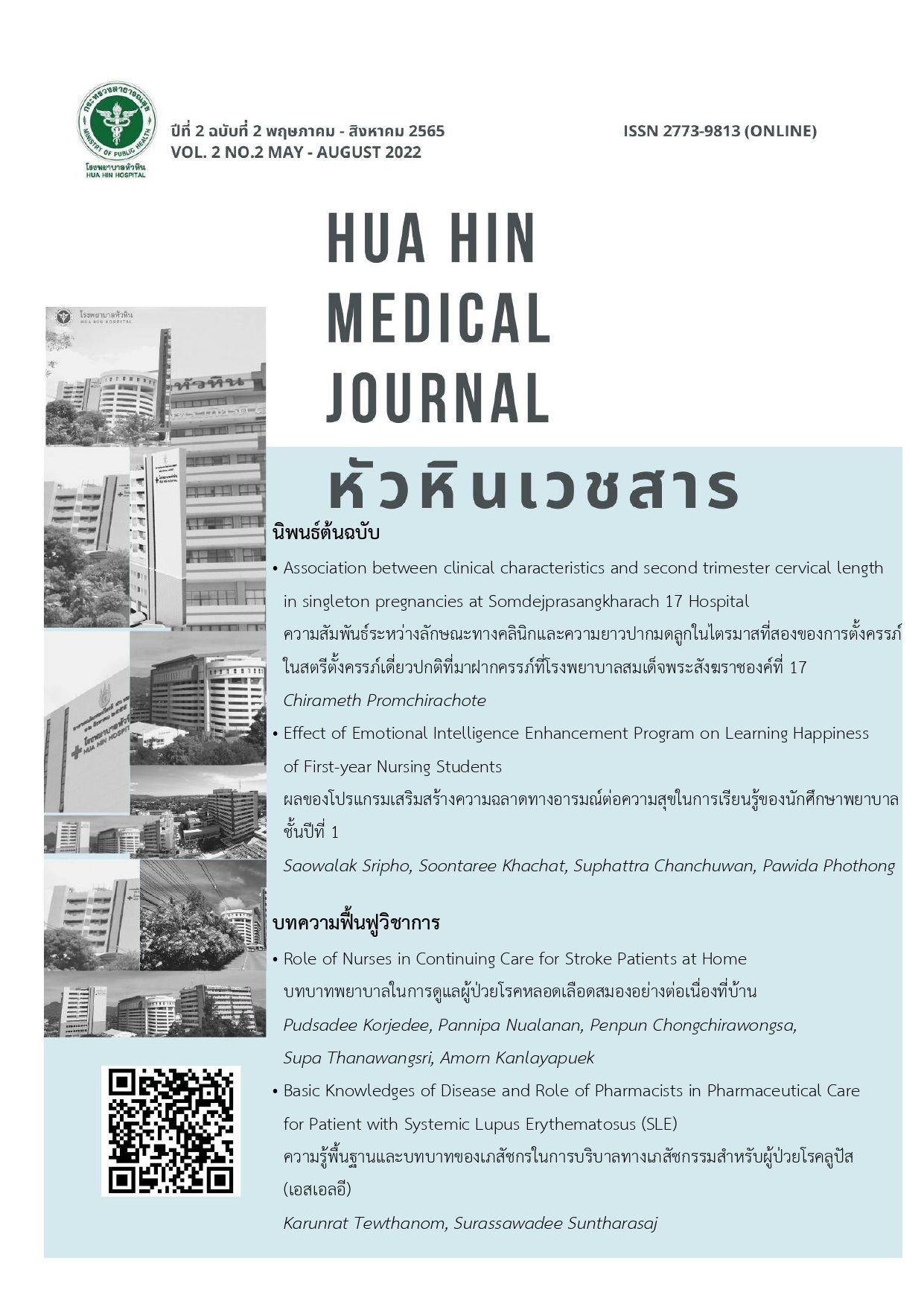Role of Nurses in Continuing Care for Stroke Patients at Home
Keywords:
Continuing care, Stroke, Nursing roleAbstract
Stroke is a neurological disease that impairs both physical and mental function. It is a chronic condition that affects patients, families, economy and societies. The role of nurses in continual care of stroke patients should start from discharge planning for patient from the beginning. Data was gathered in the stroke patient distribution plan, using the D METHOD principle to identify issues and patient requirements when returning home, as well as assessing caregivers and home environments, and nursing home visits to care for stroke patients at home using the INHOMESSS of family medicine guidelines, and supporting an appropriated equipment and environment for patient safety.
Nurses play an important role in promoting the continuous care of stroke patients at home and preventing the recurrent stroke by encouraging self-management to stroke patients and empowering caregivers and their families to provide continuing care for stroke patients
References
Feigin VL, Brainin M, Norrving B, Martins S, Sacco RL, Hacke W, et al. World Stroke Organization (WSO): Global Stroke Fact Sheet 2022. International Journal of Stroke 2022; 17(1):18-29.
สถาบันประสาทวิทยากรมการแพทย์. แนว ทางการพยาบาลผู้ป่วยโรคหลอดเลือดสมอง สำหรับพยาบาลทั่วไป. ครั้งที่ 1. กรุงเทพฯ: บริษัท ธนาเพรส จำกัด; 2559.
กองยุทธศาสตร์และแผนงาน กระทรวงสาธารณสุข. สถิติกระทรวงสาธารณสุข 2560. Retrieved from http://bps.moph.go.th/new_bps/sites /default/files/stratistics60.pdf [ 18 กันยายน 2562].
Feigin VL, Forouzanfar MH, Krishnamurthi R, Mensah GA, Connor M, Bennett DA, et al. Global and regional burden of stroke during 1990-2010: Findings from the Global Burden of Disease Study 2010. Lancet 2014;383:245- 254.
Stroke Unit Trialists’ Collaboration. Organised inpatient (Stroke Unit) care for stroke. Cochrane Database of Systematic Reviews 2013;19:CD000197.
Lindblom S, Flink M, Sjostrand C, Laska A, Koch Lv, Ytterberg C. Perceived Quality of Care Transitions between Hospital and the Home in People with Stroke. Journal of American Medical Directors Association 2020;21(12):1885-1892.
Gallacher K, Morrison D, Jani B, Macdonal S, May CR, Montori VM, et al. Uncovering Treatment Burden as a Key Concept for Stroke Care: A Systemic Review of Qualitative Research. PlOS Medicine 2013;10(6):e1001473.
รุ่งนภา เตชะกิจโกศล และงามทรัพย์ ทองจันทร์. การดูแลผู้ป่วยโรคหลอดเลือดสมองระยะ เฉียบพลัน:บทบาทพยาบาลฟื้นฟูใน: วันเพ็ญ ภิญโญภาสกุล และศรัณยา โมสิตะมงคล. การดูแลผู้ป่วยโรคหลอดเลือดสมอง: สมรรถนะของพยาบาล. พิมพ์ครั้งที่ 1. กรุงเทพมหานคร: ศูนย์โรคหลอดเลือด สมอง; 2560.หน้า 219-234.
ศรารินทร์ พิทธยะพงษ์. สถานการณ์ ปัญหา และอุปสรรคการดูแลผู้ป่วยหลังการเกิดโรค หลอดเลือดสมองระยะเปลี่ยนผ่านจาก โรงพยาบาลสู่บ้าน. วารสารพยาบาล สภากาชาดไทย 2561;11(2):26-39.
ทัศนีย์ อินทรสมใจ, ปภัสสรา มุกดาประวัติ, วันเพ็ญ ภิญโญภาสกุล. การวางแผน จำหน่ายผู้ป่วยโรคหลอดเลือดสมอง ใน: วันเพ็ญ ภิญโญภาสกุล และศรัณยา โมสิตะมงคล. การดูแลผู้ป่วยโรคหลอดเลือดสมอง: สมรรถนะของพยาบาล. พิมพ์ครั้งที่ 1. กรุงเทพมหานคร: ศูนย์โรคหลอดเลือด สมอง; 2560.หน้า 252-266.
Suksatan W & Posai V. An Integrative Review of Discharge Planning Interventions with Thai Stroke Patients. Systemic Reviews in Pharmacy 2020;11(11):1692-1700.
กนกวรรณ ช้างโรจน์, ละเอียด แจ่มจันทร์ และ จินตนา อาจสันเที๊ยะ. ผลของการใช้ โปรแกรมวางแผนการจำหน่ายตามแนวคิด M-E-T-H-O-D ต่อความสามารถของผู้ดูแล ผู้ป่วยโรคหลอดเลือดสมอง. วารสาร วิทยาลัยพยาบาลบรมราชชนนี อุตรดิตถ์ 2563;12(2):230-239.
Creer TL. Self-management of chronic illness. In: Boekarts M, Pintrich P, Seidner M, editors. Self-regulation: theory, research, andapplications. Orlando,FL: AcademicPress; 2000.p. 601-29.
วิไลเลิศ คำตัน. การจัดการตนเองในผู้ป่วยโรค หลอดเลือดสมอง: การประยุกต์ใช้หลักฐาน เชิงประจักษ์. วารสารสภาการพยาบาล 2562;34(1): 25-41.
Gibson CH. A study of Empowerment in mothers of chronically ill children (Doctoral dissertation). Boston: School of Arts and Science, Department of Nursing, Boston College; 1995.
เพชรลดา จันทร์ศรี, วรรวิษา สำราญเนตร และ นิตยา กออิสรานุภาพ. การเสริมสร้างพลัง อำนาจของผู้ดูแลในการฟื้นฟูสภาพผู้ป่วย โรคหลอดเลือดสมอง. วารสารมหาจุฬา นาคทรรศน์ 2564;8(11):112-125.
วรรณวดี คชสวัสดิ์ และ กรรณิการ์ ตัณฑ์เกยูร. การดูแลผู้ป่วยโรคหลอดเลือดสมอง ภายหลังจำหน่าย:บทบาทพยาบาลเยี่ยม บ้านใน: วันเพ็ญ ภิญโญภาสกุล และศรัณยา โมสิตะมงคล. การดูแลผู้ป่วยโรคหลอดเลือด สมอง: สมรรถนะของพยาบาล. พิมพ์ครั้งที่ 1. กรุงเทพมหานคร: ศูนย์โรคหลอดเลือด สมอง; 2560.หน้า 267-282.
วสุวัฒน์ กิติสมประยูรกุล. เวชศาสตร์ฟื้นฟูโรค หลอดเลือดสมอง.ครั้งที่ 1. กรุงเทพ: แด เน็กซ์อินเตอร์คอร์ปอเรชั่น; 2558.
สถาบันประสาทวิทยากรมการแพทย์.แนว ทางการฟื้นฟูสมรรถภาพผู้ป่วยโรคหลอด เลือดสมอง. ครั้งที่ 3. กรุงเทพฯ: บริษัท ธนาเพรส จำกัด; 2559.
ธิติมา ตั้งพิมลจิตต์. บทบาทพยาบาลชุมชนใน การดูแลผู้ป่วยโรคหลอดเลือดสมองที่มี ความเครียดและวิตกกังวล. วชิรสารการ พยาบาล 2564;23(1):75-83.
Downloads
Published
How to Cite
Issue
Section
License
Copyright (c) 2022 Hua-Hin Hospital

This work is licensed under a Creative Commons Attribution-NonCommercial-NoDerivatives 4.0 International License.
บทความที่ได้รับการตีพิมพ์ในวารสารหัวหินเวชสาร เป็นลิขสิทธิ์ของโรงพยาบาลหัวหิน
บทความที่ลงพิมพ์ใน วารสารหัวหินเวชสาร ถือว่าเป็นความเห็นส่วนตัวของผู้เขียนคณะบรรณาธิการไม่จำเป็นต้องเห็นด้วย ผู้เขียนต้องรับผิดชอบต่อบทความของตนเอง







